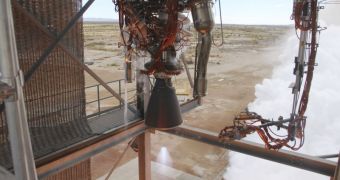Officials at Kent, Washington-based Blue Origins announce that the company has just successfully concluded a test fire of its latest design, the BE-3 rocket engine. This thruster is fueled by hydrogen and oxygen, and is being developed for a spacecraft that Blue Origin is developing with NASA support.
The company is one of the few in the United States to work with the American space agency under Commercial Crew Program (CCP) and Commercial Crew Development Round 2 (CCDev2) initiatives, which seek to create the next generation of manned spacecraft for traveling to Earth's orbit.
Blue Origins is developing its yet-unnamed Space Vehicle, which will eventually take NASA astronauts to the International Space Station (ISS) and other locations in low-Earth orbit. The BE-3 engine is a critically important step in the vehicle's development process.
In addition to the Space Vehicle, the company is also developing a new rocket to carry the spacecraft out of Earth's atmosphere. The new tests are meant to demonstrate that the delivery system can use the BE-3 rocket motor efficiently. Testing occurred near Van Horn, Texas, on November 20.
The thruster was ignited for 2 minutes and 30 seconds, and then stopped for a few minutes. Another 1-minute burn was then conducted. The goal was to simulate the exact thruster firing patterns of a suborbital launch, Blue Origin officials explain.
“Blue Origin has made steady progress since the start of our partnership under the first Commercial Crew Development round. We're thrilled to see another successful BE-3 engine test fire,” says expert Phil McAlister, who directs the Commercial Spaceflight Development program at NASA.
Unlike other companies that work with NASA under the two programs, Blue Origin is developing the Reusable Booster System (RBS) rocket in a way that will enable its use over several missions. The delivery system will not burn up in Earth's atmosphere, but rather make a controlled landing to avoid damage.
“Working with NASA accelerated our BE-3 development by over a year in preparation for flight testing on our New Shepard suborbital system and ultimately on vehicles carrying humans to low-Earth orbit,” explains company official Rob Meyerson.
“The BE-3 is a versatile, low-cost hydrogen engine applicable to NASA and commercial missions,” concludes Meyerson, who is the president and program manager of Blue Origin.

 14 DAY TRIAL //
14 DAY TRIAL //